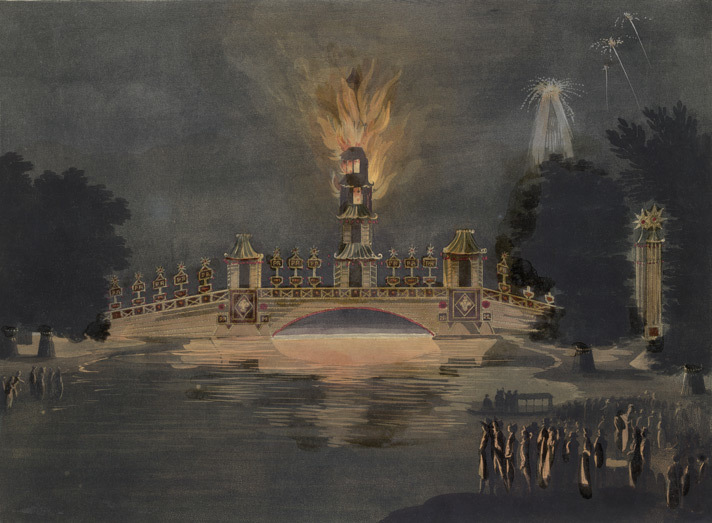
From the Crystal Palace to the Millennium Dome, London's never shied away from onanistic monuments to some achievement or other.
Back in 1814, it was the Temple of Concord — a theatrical folly erected in Green Park, to mark the signing of the Treaty of Paris, and 100 years of the Hanoverian monarchy, with suitable Regency hubris.

Masterminded by rocket designer Lieutenant Colonel Sir William Congreve, with help from Theatre Royal stage designers and master engineers, the grandiloquent mausoleum-shaped temple was covered in fabrics painted with scenes praising "the Triumph of England under the Regency", with bombastic titles like The Triumph of Britannia and The Golden Age Restored. The paintings were lit from behind by oil lamps; wrote one onlooker:
The whole fabric was so completely illuminated as to appear a building of fire, but having at the same time, the same pedestal, pillars, and all the other parts, distinctly and accurately visible with all the decorations.
There were fireworks, and lots of them too (Congreve was a rocket designer after all): "it bursts and flings aloft into the air innumerable parcels of flames, brilliant as the brightest stars".
What's more, the whole crazy structure revolved, turning on an axis like a fancy cake on a dessert carousel, for all to admire.

The grandiloquent spectacle was part of a three-day orgy — The Grand Jubilee of 1814 — which saw London more or less close down, so Londoners could indulge in various attractions strewn across Green Park, Hyde Park and St James's Park. In the latter was another firework-laden extravaganza: a Chinese-style bridge and pagoda. (The pagoda, unfortunately, went up in flames, and injured several workmen.)
All in all, this was the sort of screwy vanity project you'd expect from a certain former Mayor of London. Except by all accounts, the Temple of Concord went down a storm. Apparently:
So magnificent was the spectacle presented to the eye, that it was received with an immediate and universal burst of applause.
Alas, the Temple of Concord's fate went with less of a bang. Newspaper reports from October 1814 say how it fell 'ingloriously under the hammer', split into 100 lots and sold off piecemeal.
Peace with France was only temporary too; in the following year, Britain was having it out with France again. This eventually led to another, more permanent, monument, the Wellington Arch.

The Temple of Concord wasn't actually the first structure of its kind erected in Green Park. In 1749, the Temple of Peace — another pyrotechnic laden spectacle, this one built to to mark the end of the War of Austrian Succession — enjoyed a short-lived run, before it was hit by friendly fire (one of its own fireworks) and went the same way of the pagoda.
Some have suggested that a ring of plane trees mark the exact location of the long gone Temple of Concord, and whether or not that's true, it's the only tangible thing left. Which is still more than you can say for the Garden Bridge.



